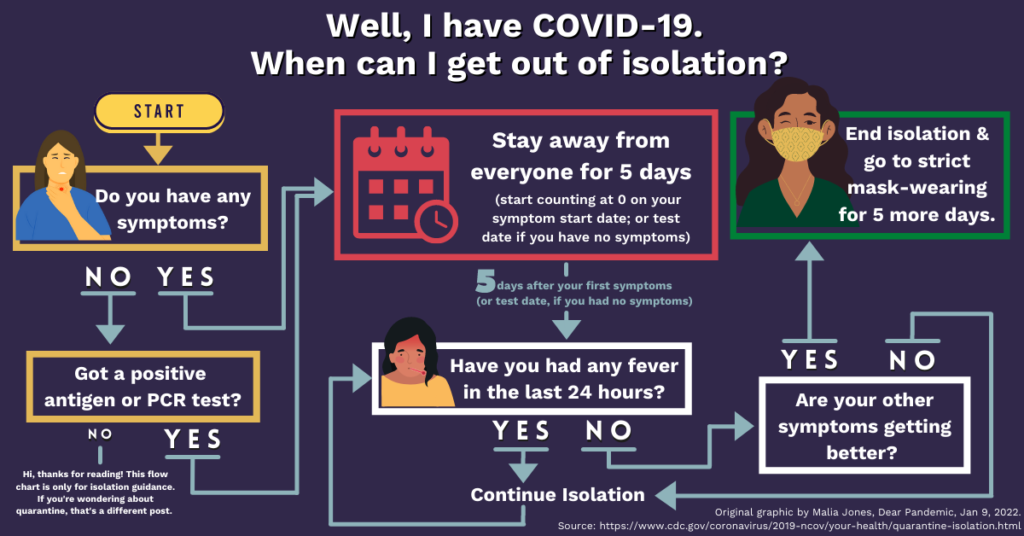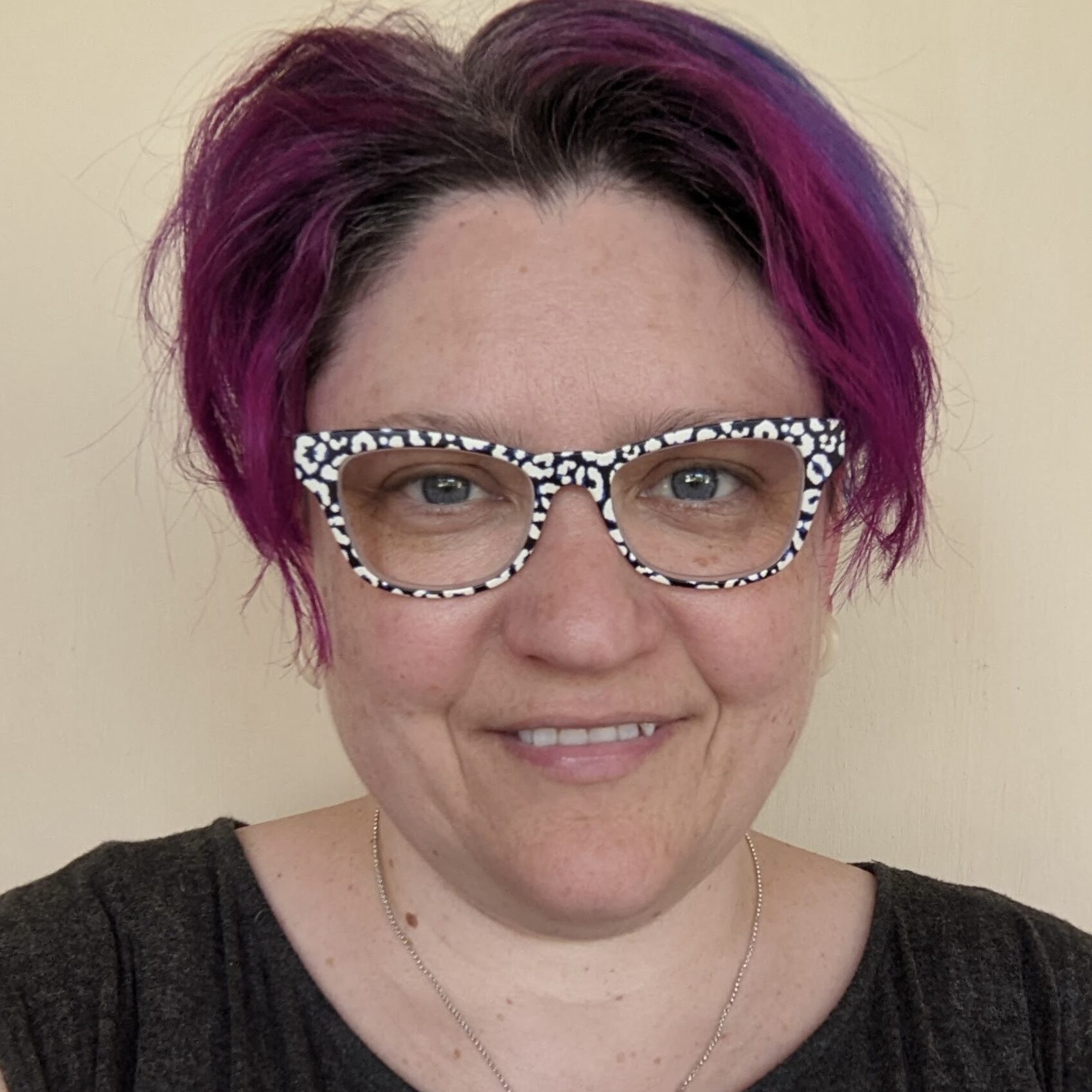The short answer is: 10 days after you first felt sick or tested positive, assuming you’re feeling better by then. If you’re not better, consult your clinician about ending your isolation period.
There have been lots of updates to these guidelines for the time periods around COVID-19 exposures and infections, and reading them can feel like doing mental gymnastics. 🤸🏽♀️🤸🏽♀️🤸🏽♀️ Isolation… quarantine… 5 days… 24 hours… if-then-or-except… are you confused yet? Is that headache from the virus or from reading the CDC guidance?! 🤯
This post will focus on the guidance for ISOLATION. There is different (but similar-sounding) guidance for QUARANTINE, which we’ll briefly cover at the bottom of this post.
_______
ISOLATION: When you know (or suspect, because you are sick) you have COVID-19 and you’re trying to avoid giving it to anyone else by *isolating* yourself. Isolation means no sharing air or physical contact with other people, even the people you live with.
_______
After you start feeling sick (or receive a positive test), you should completely avoid contact with all other people–even the people you live with–for at least 5 days full days. Start counting from 0 on the first day you had symptoms. If you never have any symptoms, count from the date your positive test was administered.
If you have to breathe the same air as other people for any reason during isolation, you and the other people should wear a well-fitted N95 type mask (not a fabric mask) whenever you are in the same room.
We are aware that it is really not possible for parents to isolate from their children. Many of us are moms. We know. If the kids have COVID-19 or you do, it will be all but impossible to keep the whole household from getting sick. CDC does not officially offer guidance here, but our advice as moms and scientists is to *do your best* and *isolate as a unit*. If one kid is sick, do not send the other one to school. Assume everyone is either infected or incubating an infection until proven otherwise. 🤒
Meanwhile, do what you can to reduce transmission within your household. Wear masks 😷, crank up the air filters, don’t share cups or utensils, and (to the extent that it is safe and possible) maintain physical distancing. If you have a very high-risk person in your household and they’re not sick yet, consider isolating them from everyone else (if you can do so safely, obviously).
_______
5 full days from your first symptoms (or positive test, if you never had symptoms) you need to ask yourself if you’re feeling better. Feeling better sooner than 5 days is great news–good for you! But it does not mean your isolation can end before 5 days.
So if it has been 5 days, and you have not had a fever for a whole day (that is, 24 hours–without the help of fever-reducing medications), CDC guidance says you can end your isolation and move on to a strict mask-wearing phase.
For 5 MORE days, you should continue to 😷 😷 wear an N95 type mask 😷😷whenever you are around other people. An estimated 1 in 3 people is still infectious on day 5, so this mask-wearing phase is important.
_______

Situations:
😓 If you are not feeling better on the 5th day after you first had symptoms, you must wait until you start to get better. Once you’ve started to see improvement and you have been free of fever for 24 hours, you can move to the mask-wearing phase for 5 more days.
🏥 If you are still not feeling better after 10 days, or you were really sick (requiring hospital care), continue isolating and ask your clinician when you should end isolation.
➕ If you never had symptoms but only had a positive test, you still need to isolate for 5 days from the date you of the test, followed by 5 more days of strict mask-wearing. It doesn’t matter if it was an antigen test or a PCR test.
➖😕➕ If you had a negative antigen test and a positive PCR test, isolate for 5 days followed by 5 more days of strict mask-wearing. If you have a positive antigen test and can’t get a PCR test, isolate for 5 days followed by 5 more days of strict mask-wearing. If you can’t or won’t test and you have any COVID-19 symptoms, you should isolate for 5 days followed by 5 more days of strict mask-wearing.
💪🩹 Vaccination will likely keep you out of the hospital, but it doesn’t matter for isolation rules. Whether you are fully vaccinated or not, if you start to feel ill or test positive (on an antigen or PCR test), the guidance is 5 days of isolation followed by 5 days of strict mask-wearing.
📅 If you have symptoms and a positive test on different days, start counting from the date of symptoms. We think. This is actually a little unclear in the CDC guidance. 🤪
👨👨👦 Multiple family members sick? Each person has their own isolation period starting from the first day THEY had symptoms (or a positive test).
_______
Strict mask-wearing means wearing a mask that fits well and has good filtration, such as an N95 mask. Strict mask-wearing means the mask is covering your 👄 mouth and 👃 nose at all times with no breaks for eating, drinking, smoking, applying Chapstick, scratching your nose, talking on the phone, or doing anything else. Mask breaks should happen away from all other people.
_______
QUARANTINE is what we do after we find out that someone we shared air with ended up being positive for COVID-19. You’re feeling fine and haven’t tested positive, but you’re in this purgatory phase where you are waiting to see if you’ll get sick. ⌛
You only have to quarantine if you are not fully vaccinated. To quarantine, you should stay at home and wear a mask around other people for 5 days. Then, you should get tested on day 5 (or 6 or 7) after the exposure. If your test is negative, you can stop quarantining at home, but continue wearing a mask and monitoring for symptoms through day 10 after exposure. You should also avoid travel and avoid people who are high-risk during this time.
If you ARE fully vaccinated, you don’t have to quarantine but you should still get tested on days 5-7 after exposure, watch for symptoms, avoid travel and wear a mask until day 10.
_______
And of course, we need to remind you that we’re explaining the CDC guidance here, not offering medical advice for your specific situation. Please consult your clinician with all your questions about your symptoms.


